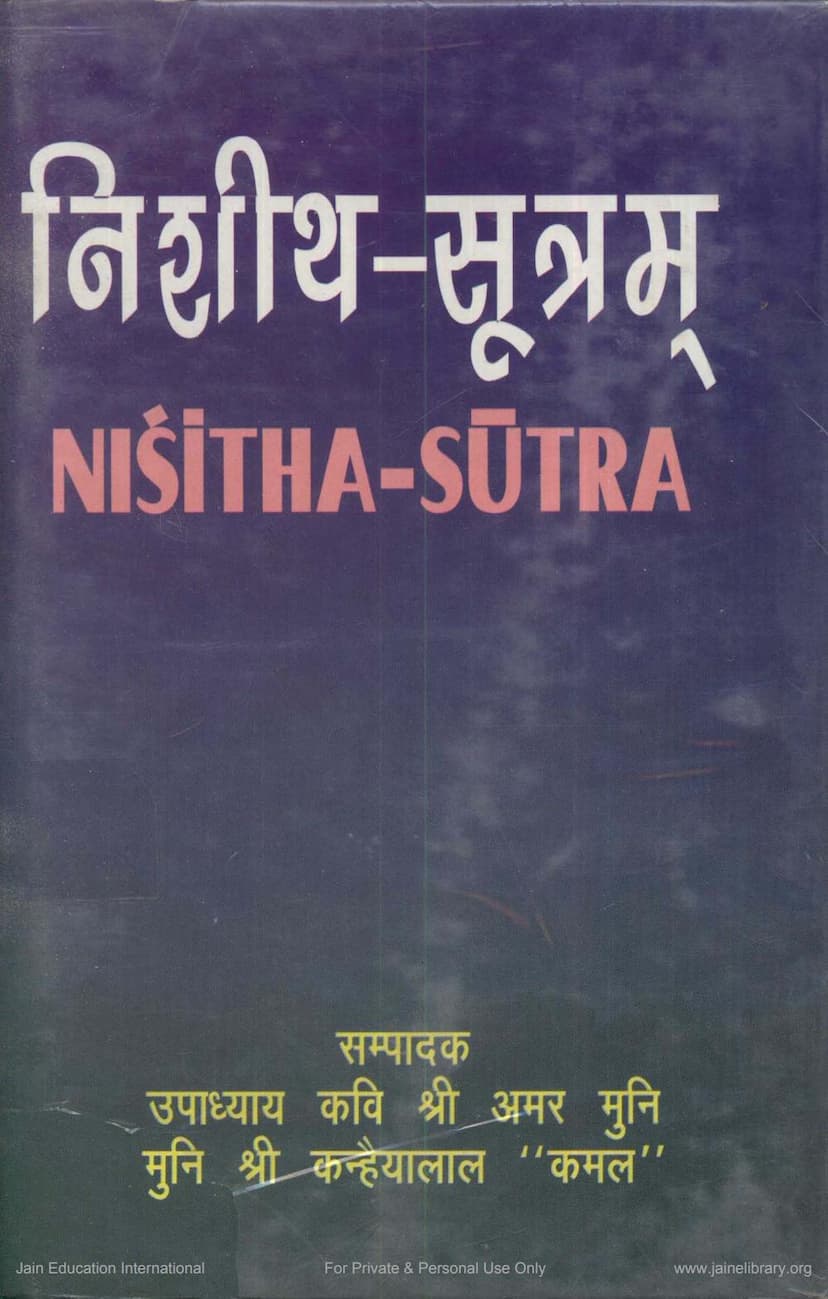Agam 24 Chhed 01 Nishith Sutra Part 03 Sthanakvasi
Added to library: September 1, 2025

Summary
This is a comprehensive summary of the Jain text "Agam 24 Chhed 01 Nishith Sutra Part 03" by Amar Muni and Kanhaiyalal Maharaj, based on the provided catalog link and page content. This summary focuses on the core themes and structure as presented in the English "About the Book" section and the Hindi table of contents and introductory pages.
Book Title: Agam 24 Chhed 01 Nishith Sutra Part 03 (With Bhashya and Vishesh Churni) Author(s): Upadhyaya Kavi Shri Amar Muni Ji Maharaj, Muni Shri Kanhaiyalal Ji Maharaj “Kamal” Publisher: Amar Publications, Varanasi-1 Edition: 2005 Language: Primarily Hindi (Sanskrit text with Hindi commentary/translation)
Overview:
The Nishith Sutra is a significant Agama text within Jainism, particularly revered by the Sthanakavasi tradition. This particular volume, Part 3, covers Chapters (Udeshikas) 10 to 15 of the Nishith Sutra. The text is highly valued for its inclusion of the Bhashya by Sthavira Pungava Shri Visahagani Mahattara and the Vishesh Churni by Acharya Pravar Shri Jindasa Mahattara.
Significance and Content:
- Encyclopedic Knowledge: The Nishith Sutra, supplemented by its commentaries, is described as an encyclopedia of knowledge.
- Conduct and Discipline: The Bhashya, in particular, elucidates various aspects of conduct relevant to specific times and places.
- Historical and Cultural Insights: It offers valuable insights into the cultural, political, social, and other aspects contemporaneous with the period of the Bhashyakara (the author of the Bhashya).
- Focus of Part 3: This volume specifically delves into Udeshikas (chapters or sections) 10 through 15. The provided table of contents (Pages 39-46 of the PDF) indicates that these chapters cover a wide array of topics related to the discipline and conduct of Jain monks and nuns.
Key Themes and Concepts Explored in the Provided Text (based on Hindi excerpts):
The introductory pages and table of contents highlight several crucial concepts within Jain monasticism as discussed in this text:
- Utsarg and Apavada (General Rule and Exception): This fundamental principle of Jain conduct is a central theme. The text emphasizes that neither extreme (utsarg) nor exception (apavada) alone constitutes complete spiritual practice. Both are essential and complementary, like two legs for a human to walk. The correct application of both depends on the specific time, place, and circumstances, and the spiritual maturity of the practitioner.
- Jain Sadhana: The core of Jain practice is the striving for self-victory (Atma-vijaya) by conquering inner defilements like anger, ego, deceit, and greed (Kashayas). It is the path to achieving liberation (Moksha).
- The Meaning of "Jain": The text explains that "Jain" derives from "Jin," meaning one who has conquered their passions. Thus, a Jain is one who strives for and achieves this state of victory over inner enemies.
- Flexibility in Practice (Yathadesh-Kaal): The text stresses that Jain practices and regulations have evolved and will continue to evolve according to time and place (Yathadesh-Kaal). Historical examples, like the differences in practices between Lord Parshvanatha and Lord Mahavira, are cited to illustrate this point (e.g., Chaturyama vs. Pancha Shiksha, Achyela vs. Sachyela).
- The Path of Samadhi: The ultimate goal of Jain sadhana is to achieve inner peace and equanimity (Samadhi Bhava). This state of pure consciousness is paramount, and the methods to achieve it can vary, provided they align with the spirit of Jainism.
- The Role of Knowledgeable Ascetics (Gitartha): The text underscores the importance of learned ascetics (Gitarthas) who possess deep scriptural knowledge and experiential understanding. They are the ones qualified to interpret and apply the complex rules of conduct, including the nuances of Utsarg and Apavada, making decisions based on context and necessity.
- Detailed Rules of Conduct: The table of contents reveals the text's meticulous attention to detail regarding monastic discipline. It covers a vast range of prohibited actions and their corresponding observances, including:
- Prohibitions related to speech (harsh words, speaking to authority).
- Rules concerning food and items (prohibitions on certain types of food, items made from specific materials like iron or copper).
- Regulations about residing in specific places and interacting with the outside world (living with different sects, accepting donations, interacting with householders).
- Prohibitions and guidelines concerning personal belongings (clothing, vessels).
- Specific rules for different situations like illness (vayaavrtya - service to the sick), and the importance of maintaining purity in all actions.
- Guidance on what constitutes an offense (Atichar) and the exceptions or alternative paths (Apavada) in specific circumstances.
- The importance of intention (Bhava) and its role in determining the ethical weight of an action.
- Specific injunctions regarding purity, non-violence (Ahimsa) in its various forms and applications, and the correct understanding of vows.
- Detailed explanations of various types of misconduct and the penitential measures (Prayschitta) to be undertaken.
Structure of Part 3:
Part 3 of this edition specifically covers Udeshikas 10 through 15. The provided table of contents gives a detailed breakdown of the topics covered within these sections, illustrating the comprehensive nature of the text's disciplinary guidelines.
Overall Purpose:
The Nishith Sutra, through its detailed examination of the rules of conduct, aims to guide ascetics towards a life of strict adherence to Jain principles, fostering spiritual purity, self-control, and ultimately, liberation. The inclusion of Bhashya and Churni indicates a deep and layered understanding and transmission of these teachings.